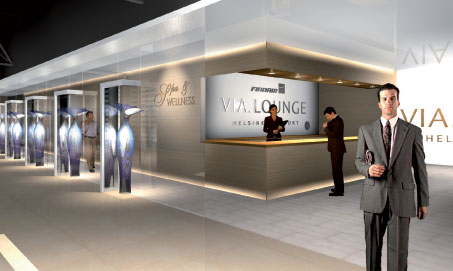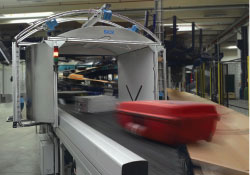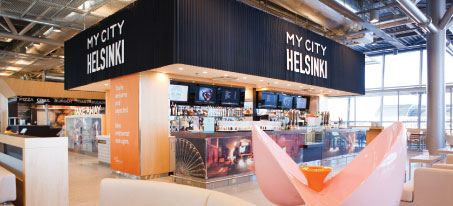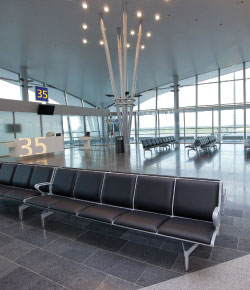
The opening of the ‘via Helsinki Spa and Wellness Centre’ in December will mark the final phase opening of the long-haul area in Helsinki’s Terminal 2 extension.
Traffic at Helsinki-Vantaa airport may be down 6.2% this year – as is demand worldwide – but Finavia has largely based its major redevelopment programme on a strategy to grow long-haul connections at the airport – for flights between North America, Europe and Asia. “This is part of our ‘via Helsinki’ concept,” explained Henri Hansson, head of Finavia’s airport engineering unit and also responsible for product management. Total traffic will, he believes, increase by 4% year-on-year once recovery occurs. “We expect the same negative outcome next year but for there to be no change in total traffic for international flights,” he conceded. Total traffic in 2008 was 13.4 million. 1.8 million of those were transfer passengers – of which 1.1 million took connecting flights to the EU and the remainder travelled outside the EU.
Terminal 2 extension

Finavia’s Hansson: “We have installed one of the RFID reading units and in the coming weeks we will assess how the process is working and the benefits. We are aiming to reach a 35-minute minimum connection time and the target is to be able to handle three wide-bodied aircraft in 15 minutes, therefore, the reading percentage for transfer luggage must be high.”
The renaming and reorganisation of Helsinki’s domestic and international facilities to Terminals 1 and 2 in August conforms with international standards, where each terminal is now dedicated to specific airlines. Renovations have also included an upgrade of signage and alterations to the service floor areas.
In Terminal 2, the new three-storey extension comprises 39,000sqm of floor space. The lower two floors are dedicated to baggage handling, while the upper floor will provide a new passenger service area to facilitate transfer flights. This will include the opening of a new ‘via Helsinki Spa and Wellness Centre’ in cooperation with SSP, which will open next month to coincide with the final opening of the extension’s long-haul area. Designed for transfer passengers, the relaxation facilities will be situated adjacent to the new lounge area and particularly targeted to Finnair’s growing number of Europe-Asia passengers. “We are trying to better accommodate the Asian transfer passenger and as well as our new services, we have introduced clearer signage for this passenger segment,” said Hansson.
Crucially, the extension will provide handling capacity for eight boarding bridges intended for wide-bodied aircraft (A340 and A350) instead of the current five. With the extension in place, Terminal 2 will have the capacity to handle 16 million annual passengers and 13.5 million items of baggage per year.
Baggage handling centre
The contract with Crisplant for a new automated baggage handling facility, to be sited in the Terminal 2 extension is for €40 million. Opening in early January, operations will begin with transfer operations, with four further phases interlinking a new baggage tunnel between the current baggage claim areas (in both terminals) and the new baggage handling centre.
Full operational flow is expected by next summer, when the existing baggage system is likely to be demolished, explained Henrik Høøck Poulsen, project director, Crisplant Airport Division. “We are now going through operational readiness trials for the first phase, which will be completed at the end of the year when the terminal extension is officially opened,” he added.
Key elements of the new Crisplant system, which are expected to drive operational efficiencies, include a modular design, allowing for easy expansion of the system, two energy-efficient (LS-4000) sortation systems which also use a smaller footprint than conventional systems and a combined RFID and bar code reader – enabling full automation of the track and trace process.
Finavia’s Hansson explained: “We have installed one of the RFID reading units and in the coming weeks we will assess how the process is working and the benefits. We are aiming to reach a 35-minute minimum connection time and the target is to be able to handle three wide-bodied aircraft in 15 minutes, therefore, the reading percentage for transfer luggage must be high.”
Crisplant’s Poulsen believes the combination of RFID and bar code technology is well-suited to the processing of transfer baggage – a common source of baggage mishandlings. “The new system will be particularly helpful for Finavia where they have flights coming in from Hong Kong which already has the RFID tag in place, as they are now well-established with using the technology.”
The key challenge, he said, will be integrating Crisplant’s CrisBag system for early bag storage (EBS). “This feature will be gradually introduced in the New Year for transfer bags and is designed to hold bags where flights arrive at the airport early and the passenger still has a long wait to catch their connecting flight.”
Commenting on Finavia’s long-term vision, Hansson said: “We want to be one of the top airports in the world for transfer traffic and we are continuing to develop for the future, with plans for more extensions.”
Finding ways to maximise use of space will be a priority through master planning, he said. “Solutions could be between the runways with a satellite terminal or developing an independent terminal, but we still have room in the airport area to grow. This planning could take us into the next five to seven years.”
A taste of Finland

The extension will provide handling capacity for eight boarding bridges intended for wide-bodied aircraft (A340 and A350) instead of the current five.
SSP Finland was awarded the tender to create a uniquely Finnish experience through airside and landside restaurants, bars and cafés at Helsinki-Vantaa. There have been a vast number of new, larger or relocated openings across Terminals 1 and 2 this year. In mid-September seven new service points opened in the Terminal 2 extension’s long-haul area, which serves departures to Asia and the US and non-Schengen countries in Europe.
The major emphasis has been on providing a flavour of Finland – particularly where transfer passengers are concerned. One example is the opening in September of a new concept – ‘My City Helsinki’ restaurant – located in the Terminal 2 extension. Kalle Ruuskanen, MD, SSP Finland, said: “My City Helsinki was designed to offer transit passengers an experience of the city, even if they’re not able to visit it themselves, as well as a compelling reason to visit Finland. We’ve also tailored a number of our offers for Asian passengers – for example sushi features on menus at many outlets.”

Kalle Ruuskanen, MD, SSP Finland: “My City Helsinki was designed to offer transit passengers an experience of the City, even if they’re not able to visit it themselves, as well as a compelling reason to visit Finland.”
Passenger comfort is an equally important element for Helsinki’s transfer passengers, she said. “Passengers will be spending more time at the airport, so we need to cater for this by, for example, incorporating seating that allows the business traveller to work in peace and quiet, or larger sofa areas for those travelling in groups.”

The upper third of the extension in Terminal 2 is dedicated to a passenger service area to facilitate transfer flights.
The latest developments are a result of SSP’s global passenger-focused research – and a collaborative effort with Finavia through sharing passenger data, said Ruuskanen.
Creating value propositions has been a further important focus for the business. “We need to offer great value, especially in the current economic climate. Our consumer value programme TravelWise, which offers a range of promotions across the terminals, is performing very well at Helsinki. Our Take and Fly-away theme is also very visible across the terminal and is popular with travellers,” she said.
“We’re also working with Finnair to maximise their own client programmes, such as frequent flyer reward points for special offers, such as a coffee and croissant deal in our cafés. New commercial opportunities are being investigated as well. Customers who visit our lounges, for example, are among the most affluent of our passengers and we’ll be thinking about how we can expand what we offer to this group.”
The passenger experience will be further enhanced with the addition of wireless computer and phone charging points in SSP’s Café Alvar A in December, followed by the lounges in January.







